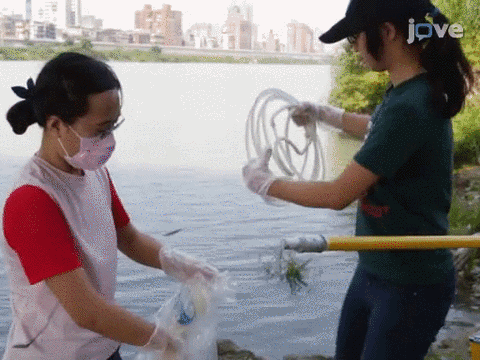Ten JoVE Video Articles featuring field methodologies from the Environment section of the journal.
The majority of science takes place in the lab which makes labs the setting for most JoVE Video Articles. However, environmental scientists and ecologists often must venture outside of the lab and into the environments, they study in order to collect samples, take measurements, and monitor organisms in their natural habitats. As the Environment Section editor at JoVE, I would like to take you on a quick journey outside of the lab with ten JoVE Video Articles featuring field methodologies.
1. The accumulation of microplastics in marine environments has emerged as an environmental concern over the last decade. Microplastics can enter the digestive system of marine organisms, blocking their digestive track or leaching toxic organic compounds that bioaccumulate and work their way up the food chain. This protocol demonstrates how to sample microplastics on the ocean surface for identification using a net attached to a marine vessel.
Microplastic Sampling (JoVE Video Article)
2. When measuring trace metals at low concentrations in aqueous environments, samples can be easily contaminated by the equipment used during collection. This protocol for river water sampling aims to avoid contamination by pre-washing all equipment and keeping it free of metal contaminants during transport to and from the field site.
River water sampling (JoVE Video Article)
3. Environmental sampling techniques can also apply below the water’s surface. The VacuSIP method was developed by researchers for sampling from specific points underwater. This method can be used to capture samples inhaled and exhaled from suspension feeders like corals and bivalves without causing harm to the organism.
VacuSIP method (JoVE Video Article)
4. The collection of soil samples is nothing new, but this approach is novel because it shows how to sample the same site repeatedly for long-term monitoring of chemical changes as a response to environmental drivers like climate change. Researchers in this video demonstrate how to excavate a soil pit to collect samples in five-year intervals and how to properly store samples for future chemical analysis.
Soil resampling method (JoVE Video Article)
5. Beech bark disease is initiated by damage caused by the feeding of invasive beech scale insects. The disease can be better managed once disease-resistant beech trees are identified using this method from the US Forest Service where insects are collected and applied directly to the trees in the field.
Method from U.S.Forest Service (JoVE Video Article)
6. This protocol features another example of an invasive species negatively impacting the environment. In South America, the invasive Africanized honey bee has chosen to make its home in nest boxes constructed to encourage the breeding of cavity-nesting birds. Researchers at The University of Florida have developed a method that pushes bees out of bird boxes by applying an insecticide and then lures the bees into traps baited with pheromones.
Method that pushes bees out of bird boxes (JoVE Video Article)
7. An understanding of arthropod population dynamics in rice fields is necessary for pest control in this important crop. Researchers at Wageningen University have developed this cheap and simple method that uses a modified leaf blower to sample 90% of arthropods within 2 minutes.
Method using a modified leaf blower (JoVE Video Article)
8. In another protocol for assessing crops, researchers apply a micrometeorological method traditionally used in atmospheric science for measuring evapotranspiration in crops.
Method for measuring evapotranspiration in crops (JoVE Video Article)
9. Conservationists need to have a better understanding of cheetah habitat ranges in order to protect Africa’s most endangered large feline. Researchers at Duke University applied this footprint measurement method previously developed for rhinoceros to the cheetah in order to monitor cheetah populations and also track individual animals.
Cheetah footprint measurement method (JoVE Video Article)
10. Researchers use radio telemetry to study the role of cognition in the navigation of free-ranging animals such as the Eastern painted turtle. After capturing turtles, radio transmitters are affixed to the turtle shell. The turtles are then dosed with Scopolamine, an mAChR antagonist, that blocks spatial memory formation and recall. Turtle movement is tracked in the field using an antenna both before and after the drug delivery to observe effects on cognition.
Method tracking turtle movement (JoVE Video Article)



